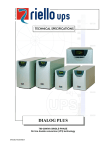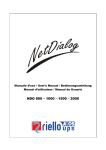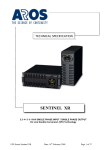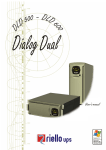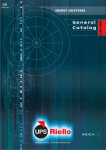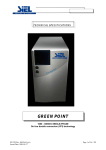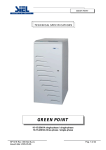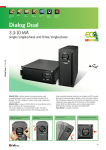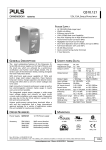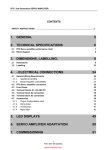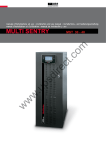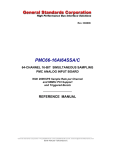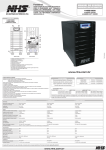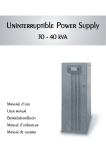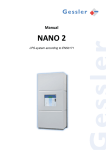Download DIALOG DUAL
Transcript
DIALOG DUAL SPECIFICHE TECNICHE TECHNICAL SPECIFICATIONS DIALOG DUAL 3,3-4-5-6 kVA SINGLE PHASE INPUT/OUTPUT On Line Double Conversion (VFI) Technology 1 SPEDDXX0205REN DIALOG DUAL Table of contents ..1.. OBJECTIVE 3 ..2.. DESCRIPTION OF THE SYSTEM 3 ..3.. APPLICATIONS 3 ..4.. CHARACTERISTICS 4 ..5.. REFERENCE STANDARDS 10 > 5.1 Main reference standards > 5.2 Standards relating to systems and installation ..6.. INSTALLATION INSTRUCTIONS 10 11 12 > 6.1 Tower or Rack installation > 6.2 Installation of the 5 and 6kVA version 14 15 ..7.. SYSTEM BLOCK DIAGRAM 16 > 7.1 Operation of the UPS > 7.2 Block diagram of the UPS > 7.3 Operating modes 16 16 18 ..8.. INTERFACING 20 > 8.1 Expansion slot 21 ..9.. OPTIONS 22 > 9.1 Summary table of options > 9.2 Replacing the Battery Pack > 9.3 Communication software > 9.4 Function of the Powershield2 communication software ..10.. CONTROL / DISPLAY PANEL 22 23 24 25 26 > 10.1 Control and signalling panel > 10.2 Display panel indications > 10.3 Measurements display area > 10.4 Configuration area 26 27 28 29 ..11.. UPS CONFIGURATION 30 ..12.. VIEWS OF THE UPS 32 > 12.1 Views Ups 3.3 and 4kVA > 12.2 Views Ups 5 and 6kVA 32 33 ..13.. TECHNICAL DATA 34 > 13.1 Models > 13.2 Back-up expansion modules > 13.3 Values summary sheet 34 34 34 2 SPEDDXX0205REN DIALOG DUAL 1 - OBJECTIVE This technical document has been produced to be used by UPS system designers and installers. The objective of this document is to provide and illustrate: - 2 the technical information required to enable you to choose the correct UPS to suit your needs the information required to set up and configure the system the information concerning the installation and location of the UPS the information the UPS displays locally to the user or to the monitoring systems it is connected to (e.g. control centres, etc.) a list of the possible options available to configure the UPS to the operators specific requirements. - DESCRIPTION OF THE SYSTEM The Dialog Dual range of UPS systems is available in 3.3-4-5 and 6kVA single/single phase models and uses On Line double conversion (VFI) technology: The load is constantly powered by the inverter, which supplies a filtered and stabilised sinewave output voltage and frequency; with the addition of input and output filters which significantly increases the immunity of the load against mains interference and disturbances. The technology used offers selectable functions (Economy Mode, Smart Active Mode, Standby/Off) and intelligent self diagnostics (digital display, RS232 and USB interfaces, communication card slot - network interface, second serial card, serial duplexer) Dialog Dual is the best solution for protecting sensitive and vital "mission critical" applications and safety devices (electro medical) with maximum reliability. 3 - APPLICATIONS => Personal computers => Small computer networks => Local Area Networks (LAN) => Workstations => Servers => Point Of Sale Systems (POS) => Data centers => Industrial PLCs => Cash registers => Electro medical devices => Emergency devices (lights/alarms) => Telecom devices 3 SPEDDXX0205REN DIALOG DUAL 4 - CHARACTERISTICS Flexibility of installation and use - The UPS can be installed as a floor standing tower or 19" rack mount UPS. The front panel digital display can be removed (using the keys provided) and rotated to suite the installation format. - Very low audible noise level (<40bBA) ensures a very low noise impact on the surrounding environment. This due to the use of high speed IGBT switching technology and PWM controlled ventilation system in relation to temperature and load applied (>20kHZ, above the audible range). Personalisation of operation The user can select the following functions from the front control panel: - Economy Mode: used to select Line Interactive (VI) technology to power non-critical loads from the mains supply. The function can be software programmed or manually set from the UPS. Smart Active: the UPS selects whether to work in on-line (VFI) or Line Interactive (VI) mode depending on the stability of the mains supply Emergency Mode: the UPS can be programmed to work only when the mains fails (suitable for emergency lighting) Frequency conversion: 50 or 60Hz Output voltage selection: 220-230-240V The software provided enables the customisation of a wide range of functions: - Auto restart: automatic restart on mains supply return - Bypass on: when the unit is switched off the loads are automatically routed through the bypass and the battery is charged - Shutdown: due to minimum load - Alarm: end of discharge - Delay: on start up - Back up limitation: restricts the back-up time available - Battery test interval: - System sensitivity: Maximum reliability for applications The system provides a filtered, stable and reliable voltage (On Line double conversion VFI technology in accordance with European standard IEC62040-3) with filters for suppressing atmospheric and mains borne disturbances. The On Line technology provides the maximum protection for the connected loads. The double conversion stage filters and stabilises the input voltage, and then reproduces it free of any disturbances such as overvoltages, variations in frequency and voltage, noise, etc. The IEC62040-3 standard defines this technology as VFI (Voltage and Frequency Independent), meaning that the output voltage and frequency are completely independent of any variations or disturbances caused to the incoming mains supply. High immunity to surges: 4kV in accordance with IEC61000-4-5 - protections against overvoltages have been provided (VDR). The UPS has been subjected to an overvoltage surge on its input, defined in the standard (IEC 801-5) as several kV, with a leading edge of 1.2 microseconds and duration of approx. 50 microseconds and maximum energy of 300 Joules 4 SPEDDXX0205REN DIALOG DUAL High level of reliability: The digital control system dramatically improves the overall reliability and efficiency of the UPS; resulting in a reduction in the number of electronic components required, the microprocessor controls and monitors all of the functions of the UPS from one common control card. The control card can be used across a number of various systems, even systems in different ranges, thereby increasing the productivity and reliability of the range. Low impact on the mains power supply - Power factor correction (UPS input factor close to 1): The UPS absorbs power from the incoming mains supply with a power factor close to 1, even if the systems supplied by the UPS have a power factor inferior to this. For example, if the UPS supplies a piece of IT equipment with an input power factor of 0.65, the UPS input power factor will still remain close to 1, ensuring that any mains supply power factor correction banks are not overloaded. - Sinusoidal absorption: The UPS draws a sinusoidal current from the mains supply, meaning that the system has a very low impact on the mains supply and, as a consequence, on the other pieces of electrical equipment connected to it. High reliability and battery availability - Hot swapping the batteries: The Dialog Dual UPS has ‘hot swap’ internal batteries. Replacement can take place whilst the UPS is powering the load from the mains supply. The UPS uses a dedicated internal battery pack with an integrated protection system. When the battery needs to be replaced, the lower front panel can be removed to provide easy access to the battery pack. Pressing the switch located above the pack informs the UPS to switch onto bypass as the battery cannot be used whilst it is being changed. The user can then release and slide out the pack and replace it as necessary by removing and then reinserting the battery connection. This operation can be carried out safely due to the integrated protection system and without any disruption caused to the load connected to the UPS. - Automatic battery test: The UPS carries out battery tests automatically; these tests enable the system to periodically check the efficiency of the batteries in order to prevent any faults occurring to them. The test does not in any way compromise the supply to the connected equipment, and given the short duration (seconds), it does not affect the life or the back-up time of the batteries. The battery test can also be activated manually from the mimic panel by pressing the “ON” key for several seconds. 5 SPEDDXX0205REN DIALOG DUAL - Active control (LRCD: Low Ripple Current Discharge) The LRCD device constantly controls the discharge of the battery system when a mains supply failure occurs, thus limiting the harmful ac component (ripple at 50 and 100Hz) normally produced during battery discharge, maintaining a low ripple prevents damage and prolongs the life of the batteries. Figure 1. ripple current without and with LRCD - High Hold Up Time (<40msec): The system can continue to operate normally even during mains supply interruptions of up to 40mS in duration, this is due to the high hold up time provided by the system. This means that the inverter continues to power the load during such interruptions without the need to draw energy from the batteries. Battery life is a function of temperature and the number of charge/discharge cycles experience so this function helps to optimise the overall battery performance. - Protection against deep discharge: The end of battery discharge voltage is automatically increased when low loads are connected to the UPS. This ensures that deep battery discharges are avoided, as these can dramatically affect the batteries operational working life. - Auto Power Off function: For automatic shutdown of the UPS with minimum loads (<5% of the nominal load): When operating from the battery, the UPS can be programmed to shut down, if the connected load is less than 5% of the nominal value. This function (programmable via software) avoids deep discharge of the battery through the unnecessary powering of very low loads or even with no load over long periods. - Unlimited expandability of back up time By means of external battery extension packs which can be supplied with or without their own internal battery charger to maintain a reasonable recharge time. 6 SPEDDXX0205REN DIALOG DUAL - Sinusoidal absorption The UPS draws a sinusoidal current from the mains supply, meaning that the system has a very low impact on the mains supply and, as a consequence, on the other pieces of electrical equipment connected to it. Maximum battery reliability - Temperature compensated charger: The system compensates for any variations in temperature whilst recharging the batteries, as temperature represents the greatest threat to the overall life and performance of the batteries. The recharge voltage is temperature dependent – the higher the temperature, the lower the recharge voltage will be. This system ensures that the batteries operate effectively, efficiently and prolongs their life. - Automatic battery test The UPS carries out battery tests automatically; these tests enable the system to periodically check the efficiency of the batteries in order to prevent any faults occurring to them. The test does not in any way compromise the supply to the connected equipment, and given the short duration (seconds), it does not affect the life or the back-up time of the batteries. The period between each test can be configured via the software, or the test can be completely deactivated. The batteries are also protected against prolonged slow discharge. An electronic device automatically disconnects the batteries if the discharge period is too long (for example when the UPS is operating on backup either with no load or with very low loads). This protects the batteries from discharging completely, which inevitably accelerates the ageing process. Advanced diagnostics: The control and display panel provides the user with all of the visual (LED and LCD) and acoustic (buzzer) signals regarding the operational status of the UPS. The panel also enables control, monitoring, diagnosis and customisation of the UPS through the easy-to-use menu system. Low consumption A low power consumption especially in the “Economy Mode” or “Smart Active Mode” functions where efficiencies of up to 98% can be achieved. - Operating modes to reduce consumption In addition to the On Line operating mode, another four operating modes are provided. These can be programmed according to user and load characteristic, these being: Economy Mode/Smart Active Mode/Emergency backup and Standby Off. - Economy Mode: Enables the user to select the Line Interactive (VI) technology, this mode provides power to non sensitive loads from the incoming mains supply for certain applications. In the event of a mains supply failure occurring or the incoming voltage or frequency exceeding the pre-determined range, the load is automatically switched onto the inverter for continued operation. This function can be programmed via the software.The tolerance range can be programmed using 3 levels of sensitivity (minimum / medium / maximum) depending on the sensitivity of the connected load. 7 SPEDDXX0205REN DIALOG DUAL Smart Active Mode - Enables the user to allow the UPS to automatically determine which method of operation (on-line or line interactive) is most suitable dependent on the quality of the incoming mains supply. If the mains supply is not within the acceptable limits for both voltage and frequency, the UPS will supply power to the load from the inverter (on-line). When the mains supply returns to within the acceptable limits, the system will first ensure that the supply remains stable, before switching the load back onto the mains supply. During both of these operating modes, the load is powered directly from the mains supply via the bypass. However, due to the EMI filters in both the input and output, the mains supply is filtered and therefore free of any electrical disturbances. If the incoming mains supply fails, the load is supplied directly by the inverter. This function reduces energy consumption as when the mains supply is present, the inverter is off. Emergency back-up mode - The UPS can function as an emergency stand-by device. This particular operating mode is configurable from the control panel or the software, and enables the supply to emergency lighting. The UPS output remains off under normal operating conditions and the batteries are charged. The output only activates when the mains power supply fails. The inverter switches on within 320ms in accordance with the current regulations, which stipulates a maximum delay time of 500ms, the inverter starts up gradually, thus preventing any sudden current surges. This operating mode enables considerable energy savings, as the inverter is off under normal conditions and therefore does not consume any energy. In addition, the system does not need to be over-sized, as the gradual start up of the inverter prevents any current surge problems that might otherwise occur. Standby-Off operation: - The UPS can be configured to power the loads through the bypass when the UPS is powered down. The battery charger remains active during this period. Flexibility of use - Automatic restart Auto restart (programmable automatic restart on mains return): It is possible to program the UPS to automatically restart after the UPS has been switched off for one of the following reasons. This can be programmed via the software supplied. Auto restart can be selected for the following scenarios: - - On mains return after the UPS has shut down due to full discharge of the batteries. On mains return after the UPS has been instructed to power down by remote UPS monitoring and management software. Programmed UPS auto shutdown if Auto Power Off has been activated due to load removal Start up from battery (cold start) The UPS can start up on inverter, even when there is no mains supply available. - Standby: Standby operation can be selected: during this mode the inverter is off and the batteries are charged. The standby function is automatically activated when the UPS is shut down and is useful when prolong periods of inactivity occur. 8 SPEDDXX0205REN DIALOG DUAL - Operation as frequency converter: The UPS can be configured (from the control panel) to function as a frequency converter, therefore when the input frequency is 50Hz the output frequency can be 60Hz and vice versa. During this mode of operation the automatic by-pass is deactivated. - Frequency auto detection The UPS can be configured to automatically select the output frequency (50 or 60Hz), by using the input frequency as its reference (50 or 60Hz). - Compact dimensions: The compact dimensions make it one of the smallest on the market: - Thanks to: microprocessor control IGBT technology internal batteries ventilation, front to rear which eliminates the need for any clearance down either side of the unit. Low audible noise (<40db(A): Achieved by: use of high frequency IGBT technology electronically controlled ventilation with PWM (Pulse Width Modulation) technology for improved cooling fan reliability and speed control in relation to the loads applied and internal UPS temperature. - special design of the magnetic components - Advanced Communication Monitoring software including shut down Powershield² provides an efficient and intuitive system for controlling and monitoring the UPS, displaying all of the most important information, such as input voltage, applied load, battery capacity, etc. using a series of bar charts. The software is able to provide detailed information even if the UPS has malfunctioned, enabling the user to find out why the fault has occurred and when. Powershield² has been developed using a client/server architecture that renders it flexible and easy to use, with multilingual support and on line help. The Powershield² software is provided free of charge with an SNMP agent, this version will operate on Windows 95, 98, 2000, Windows 2003 Server, Me, Xp, NT4.0, Novell, Mac OS, Mac Osx, Mac Os 9.x & Linux operating systems. The software enables the user to programme the automatic start-up and shutdown of the system on a weekly basis. The UPS is supplied with the following hardware interfaces: - RS232 serial port USB port isolated contacts interface network and communications card slot 9 SPEDDXX0205REN DIALOG DUAL 5 - REFERENCE STANDARDS > 5.1 Main reference standards The company quality system has been certified as conforming to ISO 9001 (Certificate No. CERT-0467499-AQ-VEN-SINCERT). This covers all of the procedures, operating methods and controls from the design stage to production, sales, through to the after sales service support. This certification guarantees the following aspects to our customers: − the use of quality materials − rigorous standards in production and testing − receptiveness and openness to our customers − constant support of all our customers As well as conforming to this certification, the company also produces “state of the art” products, as dictated by the requirements of the standards quoted below. The advances that have taken place in Information Technology systems, means that the power systems used to power them must be able to provide an absolutely precise, and even more importantly, absolutely reliable source of power. The standards produced by IEC/CENELEC in the IEC/EN62040 series, cover all aspects of the product: safety, electromagnetic compatibility and performance. In more detail, this series is divided into the following individual standards: STANDARDS EN62040-1: Uninterruptible power systems (UPS): general and safety regulations EN62040-1-1: Uninterruptible power systems (UPS): general and safety regulations for use in areas accessible to the operator EN60950 (CEI74-2): ITE (Information Technology Equipment) safety EN50091-2: Uninterruptible power systems (UPS): electromagnetic compatibility regulations. EN50081-2: Electromagnetic compatibility (immunity) IEC61000-4-2: Immunity: Electro Static Discharge (ESD) IEC61000-4-3: Immunity: electromagnetic fields IEC61000-4-4: Immunity: transitory overvoltages (BURST) IEC61000-4-5: Immunity: lightning overvoltage (Surge) IEC61000-4-11: Low frequency interference EN50141: Conducted radio interference EN55022: Radiofrequency interference EN62040-3: Uninterruptible power systems ( UPS ): regulations for performance and testing methods. 10 SPEDDXX0205REN DIALOG DUAL EN50171: Centralized power supply for emergencies (CSS) IEC146 (CEI22): Semiconductor electronic converters IEC529 (CEI70-1): Degree of casing protection European Directives 73/23 Low voltage directive requiring obligatory CE marking as from 1/1/97. This directive safeguards aspects with regard to equipment safety. 89/336 Electromagnetic compatibility directive enforcing the use of the CE marking from 1/1/96. This directive concerns all issues of immunity and emissions relating to the UPS once installed. > 5.2 Standards relating to systems and installation The above product regulations refer specifically to uninterruptible power supply systems. It is these regulations that manufacturers of uninterruptible power supply systems are obliged to adhere to. However, with regard to the electrical system, the installer must refer to other standards. − standard CEI 64-8 ( HD384/IEC60364 ) for electrical systems in general − standard CEI 64-8/7 variant 2: for installation in hospital environments − standard CEI 11-20: for systems with UPS machines connected to category I or II networks − standard CEI 17-13 ( EN60439-1 ) relating to control equipment − standard CEI 21-6/3 (EN50272): for battery installation − CEI 20: for electrical cables 11 SPEDDXX0205REN DIALOG DUAL 6 - INSTALLATION INSTRUCTIONS Equipment and accessories provided with UPS 3.3 and 4kVA The UPS system is supplied with the following items: UPS 2 plastic covers (top panels) 2 plastic keys to release the front panel display Power supply cable (Schuko/UK plug –IEC 16A socket) 2 IEC 10A connection cables RS232 serial cable IEC 16A loose plug User manual + CD-ROM with software User's m an u al Note the UPS is also supplied with a rack enclosure handles kit as shown on the next page 12 SPEDDXX0205REN DIALOG DUAL Equipment and accessories provided with UPS 5 and 6kVA The UPS system is supplied with the following items: UPS 3 plastic covers (top panels) 2 cable glands 2 plastic keys to release the front panel display Cable end ferrules RS232 serial cable Rack handles kit User manual + CD-ROM with software User's manual 13 SPEDDXX0205REN DIALOG DUAL > 6.1 Tower or Rack installation TOWER VERSION Once removed from the packaging, the UPS is ready for installation in a tower configuration. All that is needed to complete this configuration is to mount the plastic covers provided (two for the 3.3 and 4kVA and three for the 5 and 6kVA) on the top part of the UPS, following the instructions below: The 2 covers have an interlocking system: locate the specific cover mounting holes on the top part of the UPS and, with the utmost care, push in the covers gently, as shown in the figure opposite. Note: as the covers are exactly the same, they can be mounted on either side (front or back) of the top part of the UPS. 5 and 6kVA shown above RACK VERSION The sequence of operations required to convert the UPS into the rack version is described below. 1 - First remove the 4 feet from the base of the UPS. Put the UPS into a horizontal position and with a small slotted screwdriver carefully lift the pin at the centre of the foot. Once it has been lifted, remove the foot from the base of the UPS. Repeat the same operation for the remaining feet. The exact sequence to follow is shown opposite: 1 2 - Once all of the feet have been removed, the display mask must then be rotated. Insert the keys provided in to the release slots located at the sides of the display mask and exert enough gentle pressure to release the mask from the UPS, as shown in the figure opposite. 3 - Rotate the mask through 90° to suit the layout and carefully replace it in the UPS housing until a slight click is heard. 4 - Rotate the UPS 90° as required. 5 - At this point, with the UPS in a horizontal position, fasten the handles to the sides of the UPS with the specific screws as shown in the figure opposite. Note: handles and screws are included in the handles kit) NOTE: The UPS is compatible for mounting in standard rack cabinets of 600mm x 800mm or more (in width). Support brackets (guides with L-shaped support), available as options or a shelf, must be used in the rack installation due to the weight of the batteries. It is recommended that you install the UPS in the lower part of the rack cabinet for the same reason. 14 SPEDDXX0205REN 2 DIALOG DUAL > 6.2 Installation of the 5 and 6kVA version For the mains input and load connections follow the instructions as below: 1. Install a 32A magnetic-thermal switch (MCB) with a type B or C trip curve upstream of the equipment. 2. The terminals to be used for the connection of the input and output cables are located inside the IN/OUT connections drawer. Undo the screw securing the connections drawer located on the right-hand side of the drawer (see figure opposite). 3. Pull the drawer out as much as is needed to access the terminals (see figure opposite). WARNING: the drawer has a locking system to prevent it being pulled out completely. Do not try to remove the drawer completely. 4. Use 3-core cables with a cross section of 4mm2. With reference to the figure shown opposite: - Insert the cable from the 32A magnetic-thermal switch into cable guide P1 (input line). - Insert the cable from the load into cable guide P2 (output line). - Strip the cables observing the measurements provided. - Insert the stripped end in the terminals provided. 5. Connect the wires to the relative terminals strictly following the instructions set out below: B y- P a s s M a n ut e n z i o n e R emoto Remote Maintenance By-Pass Input cable a - Ensure that the magnetic-thermal switch upstream is open. b - Connect the earth wire to terminal 3. c - Connect the neutral wire to terminal 1. d - Connect the phase wire to terminal 2. P2 P1 8 7 6 5 4 Output cable a - Connect the earth wire to terminal 4. b - Connect the neutral wire to terminal 5. c - Connect the phase wire to terminal 6. 3 2 6. Ensure that a jumper is connected at terminals 7 and 8; this is needed for the UPS to operate correctly. 1 7. Secure the cable glands to the flange close the drawer and secure it with the screw previously removed. 15 SPEDDXX0205REN DIALOG DUAL 7 - SYSTEM BLOCK DIAGRAM > 7.1 Operation of the UPS Description of the UPS The purpose of a UPS is to provide a perfect power supply voltage to the equipment connected to it, regardless of the quality and stability of the incoming mains supply. Once connected and switch on, the UPS generates a sinusoidal alternating voltage with stable amplitude and frequency, regardless of any surges and/or variations present on the mains supply. Whilst the UPS draws energy from the incoming mains supply, the batteries are charged. The microprocessor continuously monitors the amplitude and frequency of the incoming mains voltage, the amplitude and frequency of the voltage generated by the inverter, the applied load, the internal temperature and the state battery charge and efficiency. The block diagram for the 3.3 and 4kVA UPS is shown below (see Fig. 5) followed by a description of the individual components. For the 5 and 6kVA UPS block diagram (see Fig. 6) shown later. > 7.2 Block diagram of the UPS Fig. 5 Block diagram of the 3.3-4kVA KEY: 1) Input protection (restorable thermal protection). 2) EMI input filter + back-feed protection: Input filter for protecting the UPS and load against any electromagnetic disturbances. Back-feed protection: intervenes when the mains power supply fails, therefore isolating the UPS from the input socket to prevent any back feed to the mains power supply. This protection is required to prevent any voltage from returning to the supply, which could put the operator at risk whilst carrying out maintenance work. 16 SPEDDXX0205REN DIALOG DUAL 3) Input fuse: The input fuse is discriminated with respect to the re-settable input fuse (1): a fault occurring to the rectifier/booster will open this protection before the thermal input fuse intervenes, ensuring that the power supply to the connected load is not interrupted, as the by-pass line will remain powered. 4) AC/DC input stage (PFC): When the mains power supply is present, this converts the mains alternating current (AC) into a direct current (DC) whilst controlling the power factor. If the mains power supply fails, it increases the voltage from the battery to an appropriate voltage level to power the inverter stage. 5) DC/AC Inverter stage: Converts the direct current (DC) into alternating current (AC) to supply the load. 6) Automatic bypass: The automatic bypass automatically switches the UPS output onto the input mains in the event of an overload and/or inverter fault. 7) Inverter switch: Transfers the load to the bypass supply. 8) Battery pack: Maintenance-free, sealed lead acid batteries: Supplies power to the inverter to support the load when the incoming mains power supply fails. 9) Battery charger: A DC-DC converter which converts the output voltage from the rectifier/booster to a suitable level to recharge the batteries, it is deactivated when the mains power supply fails. 10) Battery protection: Battery to UPS protection fuses 11) Interface card: An RS232, a USB (Universal Serial Bus) interface and isolated contacts are supplied as standard. The UPS automatically detects whether the RS232 or USB port has been selected for remote communication. 12) Network adapter and communication card slot: The communications card slot can be used to insert various interface card: for example a second RS232 serial card, an SNMP interface for communication over the computer network, an RS232 serial interface duplexer or a volt free contact card. 13) Display: The display panel provides the user with visual (LED + LCD) and acoustic (buzzer) signals relating to the status of the UPS. The panel also enables the user to control and customise the operation of the UPS. 14) Output sockets 1 x IEC standard 16 A socket + 2 x 10 A IEC sockets are available at the rear of the unit for load connection. 17 SPEDDXX0205REN DIALOG DUAL Fig. 6 Block diagram of the 5-6kVA > 7.3 Operating modes Operating modes: The default operational mode that provides maximum protection to the load is the ON LINE mode. During this mode the load is supplied with a sinewave that is stabilised and regulated in terms of voltage and frequency, the waveform is independent of the incoming mains supply (VFI technology) and controlled by the digital microprocessor. The following other modes can also be selected: ECONOMY (LINE INTERACTIVE) SMART ACTIVE (shown on the display as “SMART”) STANDBY OFF (shown on the display as “STBYOFF”) During economy mode the load is normally powered via the bypass, in order to optimise the operating efficiency. If the incoming mains supply exceeds the predefined operating range (voltage or frequency), the UPS switches to battery operation. If the user cannot decide which operating mode is the most suitable for the application (ON LINE or ECONOMY), this decision can be left to the UPS by selecting the SMART ACTIVE mode. In this mode, the UPS automatically decides which mode to use based upon an assessment of the quality and availability of the incoming mains supply. 18 SPEDDXX0205REN DIALOG DUAL The STANDBY OFF mode is used for emergency lighting applications when the load is not powered until the incoming mains supply fails, at which point the output from the UPS is switched on. Status of the mains supply and loads Comments Mains present, loads not powered* The UPS is in a condition of minimum power consumption because the booster and the inverter are switched off. The microcontroller is powered and carries out supervision and selfchecking functions, the batteries are charging and everything is ready for the UPS to be started up. The UPS only operates in stand-by mode from the batteries if it has been set for programmed start up via software. Operating mode STANDBY ON-LINE ON-LINE ON-LINE LINE-INTERACTIVE LINE-INTERACTIVE LINE-INTERACTIVE Mains present, loads powered from the inverter with energy drawn from the mains Mains present, loads powered from bypass Mains absent, loads powered from the inverter with energy drawn from the batteries Mains present, loads powered from bypass Mains present, loads powered from the inverter with energy drawn from the mains Mains absent, loads powered from the inverter with energy drawn from the mains This is the normal state for this operating mode. The loads are powered from the inverter with a frequency and voltage stabilised waveform. The battery chargers ensure that the batteries are charged. The UPS goes into this state on start up from the mains (before passing to the inverter), or when a distorting load is applied or there is a temporary overload The UPS goes into this state when the mains fails (Black out) or goes out of the admitted range (overvoltage or undervoltage). The loads are powered from the inverter with a frequency and voltage stabilised waveform and energy is received from the batteries. This is the normal state for this operating mode. The loads are powered from the bypass through the internal EMI filters when the mains returns within the set voltage and frequency ranges; the batteries are charged. The UPS goes into this state when the bypass (mains) voltage and frequency go out of the set range. The UPS goes into this state when the mains fails (Black out) or goes out of the admitted range for operation from the mains (overvoltage or undervoltage) * if the StandBy Off function, which provides power to the load when the unit is switched off by means of the Bypass circuit, is not set. Emergency Power Off (EPO) (version 5 and 6kVA) This isolated input is used to switch off the UPS remotely in an emergency. Any remote “Emergency Power Off” (EPO) switch that is normally closed must be connected to the connector located at the back of the UPS. The UPS is supplied with the EPO terminals short circuited: remove the short circuit if this contact is to be connected to the auxiliary of a remote emergency switch. The EPO circuit is self-powered with SELV type circuits. No external power supply voltage is therefore required. When it is closed (normal condition) there is a current of 10mA max. Programmable auxiliary socket (PowerShare - 5 and 6kVA versions) The UPS is provided with two output sockets which can be programmed to switch off or remain on during a mains supply failure – PowerShare. The events that trigger the PowerShare can be user-selected using the UPSTools configuration software (see paragraphs Configuration software and UPS Configuration). It is possible for example to select switch off after a certain time of operation from battery, on reaching the end of a battery discharge pre-alarm threshold, or during an overload condition. 19 SPEDDXX0205REN DIALOG DUAL 8 - INTERFACING Communication ports The UPS is supplied with an RS232 and USB serial interface. The serial interface must be supplied with a +/- 12V isolated power supply. The serial interface has a female sub-D 9-pole connector that carries the signals for the interface (fixed baud rate =1200) and three auxiliary opto-isolated contacts with the following pin configuration: Pin 7 2 3 8 9 Name +12V TX RX BL BW 1 5 ALARM GND Function Notes Serial transmission line Serial receive line Auxiliary opto-isolated contact Auxiliary opto-isolated contact Auxiliary opto-isolated contact Signals end of discharge Signals operation from battery or mains fail Signals operation from by-pass In addition to the USB and serial port, the UPS also has an expansion slot located at its rear, where various types of interfaces can be inserted. For example a second serial/USB, serial multiplexer. The signals sent to the slot are shown in the table below. PIN NAME TYPE FUNCTION NOTES 1 Not used 2 Not used 3 ALARM UD Signals UPS fault 4 INIT UD System initialisation 5 REMOTE ON ID Remote UPS start up 6 Not used 7 Not used 8 REMOTE OFF ID Remote UPS shutdown 9 INVOFF ID Inverter shutdown and passage onto bypass 10 BL UD Signals end of discharge 11 BW UD Signals operation from battery 12 BY-PASS UD Signals operation from bypass 13 DCD2 ID DCD secondary serial line 14 DTR2 UD DTR secondary serial line 15 Not used 16 +5V PWR 17 Not used 18 +12V PWR 19 Not used 20 Not used 21 Not used 22 RX2 ID RX secondary serial line 23 TX2 UD TX secondary serial line 24 GND PWR 25 Not used 26 Not used Where UD = digital output, ID = digital input, PWR = power signal. The communication protocol used for the remote control of the UPS via the serial port is: PSGPSER. 20 SPEDDXX0205REN DIALOG DUAL > 8.1 Expansion slot The UPS has an expansion slot for a wide range of interface cards (see figure opposite): UPS • Second RS232 port • Serial port duplexer • Ethernet network agent with TCP/IP, HTTP and SNMP protocol • RS232 + RS485 port with JBUS / MODBUS protocol • Volt free contact signalling relay card 21 SPEDDXX0205REN DIALOG DUAL 9 - OPTIONS > 9.1 Summary table of options Description Battery expansion pack for DLD 3300VA rack/tower version (9 12V-7Ah batteries) Battery expansion pack for DLD 3300VA rack/tower version (9+9 12V-7Ah batteries without battery charger) Battery expansion pack for DLD 3300VA rack/tower version (9+9 12V-7Ah batteries with battery charger) Battery expansion pack for DLD 4000VA rack/tower version (9 12V-7Ah batteries) Battery expansion pack for DLD 4000VA rack/tower version (9+9 12V-7Ah batteries without battery charger) Battery expansion pack for DLD 4000VA rack/tower version (9+9 12V-7Ah batteries with battery charger) Battery expansion pack for DLD 5000VA rack/tower version (16 batteries 12V-7Ah without battery charger) Battery expansion pack for DLD 5000VA rack/tower version (16 batteries 12V-12Ah without battery charger) Battery expansion pack for DLD 5000VA rack/tower version (16 batteries 12V-12Ah with battery charger) Battery expansion pack for DLD 6000VA rack/tower version (16 batteries 12V-7Ah without battery charger) Battery expansion pack for DLD 6000VA rack/tower version (16 batteries 12V-12Ah without battery charger) Battery expansion pack for DLD 6000VA rack/tower version (16 batteries 12V-12Ah with battery charger) Mains adapter pack on slot Communication software Interface card, second serial card Handles kit (for rack version) Dimensions (HLD) mm Weight (Kg) 455x175x520 30 455x175x520 50 455x175x520 50 455x175x520 30 455x175x520 50 455x175x520 50 455x175x660 60 455x175x660 80 455x175x660 80 455x175x660 60 455x175x660 80 455x175x660 80 Battery expansion pack: This is used to extend the UPS back up time. It is supplied in a metal cabinet to match the UPS and is available without or with an additional battery charger to help maintain reasonable recharge times. 22 SPEDDXX0205REN DIALOG DUAL > 9.2 Replacing the Battery Pack As mentioned in the introduction, the UPS comes with dedicated battery packs (1 in the 3.3 and 4 kVA and 2 in the 5 and 6kVA) that can be safely and easily ‘hot-swap’ replaced, VERSION 3.3 - 4kVA VERSION 5 - 6kVA The battery pack is located behind the front panel of the UPS. Hold the panel centrally from the sides and gently pull it outwards as shown in the figure at the side. Press the circuit breaker located under the front panel putting it into position “II” as shown in the figure opposite. When the breaker is in this position, the load is powered from the bypass and the display should show the message C02. If during the replacement procedure you should forget to switch the breaker back to position “I”, this will be done automatically when the front plastic cover is reconnected. The battery pack is connected to the rest of the UPS via a cable with terminal. Referring to the figure on the left hand side for the 3.3 and 4kVA version: press the 2 tabs at the sides of the terminal ( A ) and remove it by gently pulling it upwards. Use your thumbs to press the 2 fastening hooks ( B ) together and, keeping them pressed, insert your index finger in the slot underneath the connector ( C ). Referring to the figure on the right hand side for the 5 and 6kVA version:: take hold of the connector ( A ) and remove it by gently pulling. Undo the two screws securing the battery pack to the UPS ( B ) and take hold of the handle ( C ) for removal. Holding the position described in the previous step, remove the battery pack by pulling it outwards, as shown in the figure at the side. Insert the new battery pack in the compartment and slide it in until it engages with the UPS. Reconnect the cable with terminal to the connector, put the circuit breaker back to position “I” and close the front panel. Check that the display has returned to normal display mode. If the installation procedure is not performed correctly, or if some of the sections are missed out (such as reconnecting the battery connector), the display will show an alarm message 23 SPEDDXX0205REN DIALOG DUAL > 9.3 Communication software MAIN FEATURES 1) Sequential shut-down with defined priority: PowerShield2 enables the user to shutdown the network without having to individually switch off each PC or server, and before doing so, Powershield² will save the work that was being done regardless of the application that was being used. The user may also define their own shutdown procedure and also prioritise the shutdown of critical components within the system (such as vital and non vital servers). 2) Multiplatform compatibility: PowerShield2 provides the user with a standard control and monitoring capability, using TCP/IP communication protocol. This enables the user to monitor computers that use different operating systems from a single console. For example, not only could the user monitor a UNIX server from a PC with Windows 98, the user could also connect to UPS systems situated in different locations by using either a dedicated network (intranet) or the Internet. 3) Events scheduling: PowerShield2 enables the user to define their own shutdown/switch off and on procedures, for the systems that are connected to the UPS. Not only does this noticeably increase the degree of security of the system, it also enables the user to make significant energy savings. 4) Management of messages: PowerShield2 keeps the user constantly informed of the status of the UPS, whether locally or by sending messages to users connected to the network. It is also possible to create a list of the people who will receive messages by e-mail, fax and SMS should a fault or sudden blackout occur. 5) Integrated SNMP agent: PowerShield2 contains an integrated SNMP agent for managing the UPS via SNMP. This agent is able to send all of the information regarding the UPS and is capable of generating traps using the RFC 1628 MIB standard. This enables the user to control the UPS using SNMP compatible workstations such as HP Open View, Novell Managewise and IBM NetView. OPERATING SYSTEMS SUPPORTED (Powershield² FULL version ) - Windows 95, 98, Me, NT 4.0, Win 2000, Win 2003 Server, XP. Novell Netware 3.x, 4.x, 5.x, Intra NetWare IBM OS/2 Warp and Server, Mac OS, 9.X, OSX The most commonly available UNIX systems such as: IBM AIX, HP UNIX, SUN OS SPARC, SUN Solaris INTEL and SPARC, SCO Unix and UnixWare, Siemens SINIX, Silicon Graphic IRIX, Compaq True64 UNIX and DEC UNIX, Linux, BSD UNIX and FreeBSD UNIX 24 SPEDDXX0205REN DIALOG DUAL > 9.4 Function of the communication software 1) Graphic monitoring of UPS status PowerShield2 is the easy to use yet powerful program that enables the user to monitor and control the UPS systems. There are various graphical versions including Windows, Java, OS/2 and MacOS. 2) Version for MacOS The PowerShield2 software is the only UPS control and shutdown software available for the Macintosh that has a client-server architecture. Enabling the user to access the Windows, Novell, IBM OS/2 and the most commonly available UNIX operating systems, when using a TCP/IP network. It also enables the user to support the NetMan series network agents to control the UPS via a network, and furthermore, comes with multilingual support. 3) Detailed display with all UPS values PowerShield2 provides all the data required to make an accurate and swift assessment of the UPS operation and status. 4) UPS block and operating diagrams PowerShield2 displays a block diagram of the UPS, thus providing the user with conceptual information as to the status of the system. 5) Saving the event history log and graphic display of the main values All of the events regarding the operation of the UPS are saved and recorded, thus allowing the user to monitor such data as the input voltage, applied load or the remaining back-up time available from the batteries. 6) Alarm notification via e-mail and SMS It is possible to configure PowerShield2 to automatically notify of an alarm via an e-mail or SMS message. 7) Programming UPS controls Enables the user to program all of the commands that would normally be carried out manually, to be performed automatically, for example: shutting down or switching the servers back on, UPS battery test, etc. 25 SPEDDXX0205REN DIALOG DUAL 10 - CONTROL / DISPLAY PANEL > 10.1 Control and signaling panel View of the display 11 9 10 8 1 2 Display LCD 3 4 5 6 7 1 Regular operation 7 Configuration area 2 Operation from mains 8 Service intervention 3 Operation from battery 9 Timer 4 Load on bypass 10 Measurements display 5 Battery level indicator 11 Stand-by / fault 6 Load level indicator The upper part of the front panel houses a display with yellow/green reversed backlighting. The layout of the display, designed to Riello UPS specifications, can be divided into 3 basic areas. The first area, consists of the icons on the left and a red triangle, this area is dedicated to the UPS status (on mains, on battery, on bypass, normal operation and alarm). The second area comprises of two bar graphs, numerical indications and the upper part of the central area is reserved for measurements. The two bar graphs show the load and percentage of battery charge, while the numerical indications show the input frequency and voltage, output frequency and voltage, estimated battery back up time (mins), estimated battery charge level (%), battery voltage, load in percentage and the current and temperature of the internal heat sinks. Each of these indications has a name and unit of measurement; press the middle button under the display to scroll from one to the other. The same figures are also used to indicate alarm or lock up codes. 26 SPEDDXX0205REN DIALOG DUAL The last area on the right consists of the set-up area which is accessed by pressing down the middle button for several seconds. The output voltage and frequency and the operating mode can be changed directly from the front panel (removing the need to use dip switches). The visual signals can be accompanied by a audible buzzer that provides an acoustic alarm in the following cases: - on start up / shutdown when the output is synchronized with the input transfer from inverter to bypass and vice versa during operation from the battery during overload during a fault or lock > 10.2 Display panel indications This section describes in detail all the information that can be shown on the LCD display. All the information displayed can be divided into three main groups: UPS status indicators Measurements display area Configuration area UPS status indicators ICON STATUS DESCRIPTION Constant Indicates a fault Flashing The UPS is in stand-by state Constant Indicates normal operation Constant The UPS is operating from the mains Flashing The UPS is operating from the mains, but the output voltage is not synchronised with the mains voltage Constant The UPS is operating from the battery. When it is in this state the UPS emits an audible signal (beep) at regular intervals of 4 sec. Flashing End of discharge pre-alarm. Indicates that the battery back up time is coming to an end. In this condition the UPS emits a beep at regular intervals of 1 sec. Constant Indicates that the loads connected to the UPS are powered from the bypass 27 SPEDDXX0205REN DIALOG DUAL Dynamic If the UPS is operating from the mains, it indicates the battery charge status (%). If the UPS is operating from the battery, it indicates the battery back up time (%) Dynamic Indicates the % of load applied to the UPS with respect to the nominal value Flashing A Service is required (service centre). Contact your local Riello UPS service center. Constant Indicates that the timer is activated (UPS auto-start up and/or autoshutdown). The timer can be activated/deactivated via the software provided > 10.3 Measurements display areas The most important UPS measurements can be shown in sequence on the display. When the UPS is started up, the display shows the value of the mains voltage. To go on to a different display press the “SEL / SET” button repeatedly until the required measurement is displayed. If a fault / alarm (FAULT) or a lock (LOCK) should occur, the type and corresponding alarm code is automatically shown on the display. Some examples are shown below: GRAPHIC EXAMPLE (1) DESCRIPTION GRAPHIC EXAMPLE DESCRIPTION Mains voltage Total battery voltage Mains frequency Percentage of the applied load Voltage output from the UPS Current absorbed by the load Frequency of the output voltage Temperature of the cooling system for the UPS internal electronics Estimated battery back up time Fault / Alarm (2): the corresponding code is displayed Percentage of battery charge Lock (2): the corresponding code is displayed 28 SPEDDXX0205REN (1) DIALOG DUAL > 10.4 Configuration area The configuration area groups together the main UPS operating parameters and displays its current status. The parameters contained in this area can be changed directly from the display panel. CONFIGURABLE PARAMETERS: Frequency: Output voltage frequency Frequency Voltage: Output voltage Voltage Mode: UPS operating mode Mode The figure opposite shows the setup display area (configuration area) showing the three configurable parameters. HOW TO CHANGE THE SETTINGS: To access the configuration area, hold the “SEL / SET” button down for at least 2 sec. The word “SET” will light up and an arrow ( d ) will appear to the left of Frequency. The arrow shows the selected setting. To select a different parameter press the “SEL / SET’ button. To change the selected item, press the “ON” button. To exit from the configuration area, hold the “SEL / SET” button down for at least 2 sec. POSSIBLE SETTINGS Frequency: d 50 Hz d 60 Hz d Off (frequency auto-sensing) Voltage: d 220 V d 230 V d 240 V Mode: d ON LINE d ECO d SMART 29 SPEDDXX0205REN d STBYOFF DIALOG DUAL 11 - UPS CONFIGURATION The following table shows all the possible configurations available to customise the UPS to the user’s requirements. KEY: = Indicates that the configuration can be changed from the display panel as well as by the configuration software provided. = Indicates that the configuration can only be changed via the configuration software provided. FUNCTION DESCRIPTION Output frequency To select the nominal output frequency Output voltage To select the nominal output voltage To select one of the 4 Operating mode different operating modes DEFAULT POSSIBLE CONFIGURATIONS • • • 50 Hz 60 Hz Auto: automatic sensing from the input frequency • • • • 220V 230V 240V 220 - 240 in 1V steps (only via the software) ON LINE • • • • ON LINE ECO SMART ACTIVE STAND-BY OFF Auto 230V Start up delay Delay before automatic restart on the mains returns 5 sec. • • Disabled 1 - 255 in 1 sec. steps Shutdown due to minimum load Automatic shutdown of the UPS when operating from the battery if the load is less than 5% Disabled • • Enabled Disabled Disabled • • Disabled (full battery discharge) 1 - 65000 in 1 sec. steps Back up time limit End of discharge alarm Maximum time of operation from the battery Estimated remaining back up time for the end of discharge alarm 3 min. 1 - 255 in 1 min. steps 30 SPEDDXX0205REN MODE DIALOG DUAL FUNCTION DESCRIPTION PREDEFINED POSSIBLE CONFIGURATIONS Battery test Time interval between the automatic battery test 40 hours • • Disabled 1 - 1000 1 hour steps Alarm threshold for maximum load Selects the user overload limit Disabled • • Disabled 0 - 103 in 1% steps Display brightness Selects the level of brightness of the LCD display Maximum Acoustic alarm Selects the operating mode of the acoustic alarm Low Minimum ÷ Maximum in 20 steps • • Normal Low: does not sound for momentary bypass intervention ADVANCED FUNCTIONS Input frequency tolerance Selects the allowed input frequency range for the transfer to bypass and for synchronisation of the output ± 5% Bypass voltage thresholds Selects the allowed voltage range for the transfer onto bypass Low: 180V High: 264V Bypass voltage thresholds for ECO Sensitivity of intervention for ECO • • • • ± 0.25% ± 0.5% ± 0.75% ± 1 - ±10 in 1% steps Low: 180 - 200 in 1V steps High: 250 - 264 in 1V steps Selects the allowed voltage range for Low: 200V Low: 180 - 220 in 1V steps High: 253V High: 240 - 264 in 1V steps operation in Economy mode Selects the sensitivity • Low of intervention during Normal • Normal operation in • High Economy mode Power supply of the load in standby Bypass operation Power supply of the load on bypass with UPS switched off (standby state) Selects bypass line operating mode Disabled (load NOT powered) Normal • • • • • 31 SPEDDXX0205REN Disabled (not powered) Enabled (powered) Normal Disabled with input / output synchronisation Disabled without input / output synchronisation MODE DIALOG DUAL 12 - VIEWS OF THE UPS > 12.1 Views UPS 3.3 and 4kVA 32 SPEDDXX0205REN DIALOG DUAL > 12.2 Views UPS 5 and 6kVA Release slots Rotatable display Manual bypass switch Main switch Battery pack Removable front panel Cable with terminal Cable with terminal Battery pack (front panel removed) (front panel fitted) Front view Fan Battery expansion connector COMMUNICATION SLOT RS232 communication port IEC 10A PowerShare sockets USB communication port PowerShare sockets thermal breaker IN / OUT connections box Emergency Power Off. (EPO) Rear view 33 SPEDDXX0205REN DIALOG DUAL 13 - TECHNICAL DATA > 13.1 Models Dialog Dual Model MODEL Dialog Dual DLD 3300VA tower Dialog Dual DLD 3300VA rack Dialog Dual DLD 4000VA tower Dialog Dual DLD 4000VA rack Dialog Dual DLD 5000VA tower Dialog Dual DLD 5000VA rack Dialog Dual DLD 6000VA tower Dialog Dual DLD 6000VA rack POWER 3300VA/2300W 3300VA/2300W 4000VA/2400W 4000VA/2400W 5000VA/3500W 5000VA/3500W 6000VA/4200W 6000VA/4200W BACK UP TIME ( min ) 12 12 10 10 10 10 8 8 DIMENSIONS (HLD) mm 455x175x520 4Ux483x520 455x175x520 4Ux483x520 455x175x660 175 (4U)x483x660 455x175x660 175 (4U)x483x660 > 13.2 Back-up expansion packs For types and back up times of the Dialog Dual models refer to the Riello Ups's price list. > 13.3 Values summary sheet MODELS 3300 4000 5000 6000 INPUT Input phases Nominal voltage Maximum input voltage without battery Minimum input voltage without battery (applied load 100%) Minimum input voltage without battery (applied load 50%) Nominal frequency Maximum current 1 220-230-240Vac single-phase 276Vac single-phase 164Vac single-phase 84Vac single-phase 50-60Hz +/-5 Hz 15 A 34 SPEDDXX0205REN 16 A 25 A 30 A DIALOG DUAL MODELS Nominal current Power factor Current distortion (THDi) Input protection 3300 11 A Bypass protection Back up time in minutes No. of batteries Nominal battery voltage Type of battery Configuration of the batteries Type of recharge Recharge current Recharge time Intervention time (mains failure) 6000 22 A >0.98 Resettable thermal protection 16A Overvoltage protection (VDR) <6% Resettable thermal protection 16A Overvoltage protection (VDR) 40ms BY-PASS Overvoltage protection (VDR) Overvoltage protection (VDR) ≥ 35ms 264V single-phase 180V single-phase ± 5% of the selected frequency (configurable) Resettable thermal Resettable thermal Overvoltage protection Overvoltage protection protection 16A protection 16A (VDR) (VDR) Overvoltage protection Overvoltage protection (VDR) (VDR) BATTERY 12’ 10’ 18’ 13’ 9 16 108Vdc 192Vdc Lead acid, maintenance free High efficiency In series Single level (floating) 1A 6-8h Zero Nominal battery connector voltage 108Vdc 35 SPEDDXX0205REN 5000 18 A <7% “Hold up” time Maximum acceptable voltage for switching onto mains Minimum acceptable voltage for switching onto mains Frequency tolerance accepted for switching 4000 12 A 192Vdc DIALOG DUAL MODELS Nominal power supplied Recharge voltage End of discharge voltage Stability of the battery voltage (fully charged) Battery protection 3300 2600 4000 2700 5000 3400 122V 85,5V 6000 4070 217V 152V 0.7% Fuse 35AGF Fuse 35AGF Fuse 35AGL Fuse 35AGL OUTPUT Nominal voltage Waveform Frequency Operation as frequency converter Current crest factor (in accordance with standard EN62040-3) Nominal power (VA) Nominal power (W) Static variation Dynamic variation (with impact of the load from 0 to 100%) Variation of the output frequency with mains absent Speed of frequency variation (Hz/s) Restored voltage after dynamic variation Voltage distortion (linear load) Voltage distortion (non linear load) 220/230/240Vac selectable Sinusoidal 50/60Hz auto-sensing or selectable YES (with batteries) 3:1 3300 2300 6000 4200 <5% <0.1% <1 <20ms <2% <6% <5% OVERLOAD TIMES Overload on battery 60’’ 60’’ 4’’ 4’’ 0.5’’ 0.5’’ 1.5In for 0.5’’ 1.5In for 0.5’’ Overload from the bypass 36 SPEDDXX0205REN 5000 3500 ±1% 100%<Load<=110% 110%<Load<=150% Load>150% Maximum effective inverter current 4000 2400 <5% 60’’ 4’’ 0.5’’ 60’’ 4’’ 0.5’’ 1.5In for 0.5’’ 1.5In for 0.5’’ DIALOG DUAL MODELS 100%<Load<=110% 110%<Load<=150% Load>150% 3300 120’’ 4’’ 1’’ 4000 120’’ 4’’ 1’’ 5000 120’’ 4’’ 1’’ 6000 120’’ 4’’ 1’’ 85% 85% 88% 88% 89% 89% 91% 91% 90% 90% 92% 92% 90% 90% 92% 92% 98% 98% 98% 98% SUNDRY AC/AC performance (Double conversion operation) 25% of load AC/AC performance (Double conversion operation) 50% of load AC/AC performance (Double conversion operation) 75% of load AC/AC performance (Double conversion operation) 100% of load AC/AC performance (Line Interactive operation) Maximum permanent operating temperature Operating ambient temperature Recommended operating temperature (for the batteries) 40°C 40°C 20/25°C Humidity <90% non condensing Protections Battery overvoltage - Inverter overvoltage (on peak) - Inverter voltage out of tolerance Back feed protection (input supply relay to isolate the UPS input with mains absent) YES NO Safety compliance EN62040-1-1 Directives 73/23/EEC and 93/68/EEC EMC compliance EN50091-2 cl. A, directive 89/336/EEC Immunity to surges IEC61000-4-5 (protections for overvoltage (VDR) Noise <40dB(A) 37 SPEDDXX0205REN <45dB(A DIALOG DUAL MODELS 3300 4000 5000 DIMENSIONS (Tower version) 455 455 455 0175 175 175 520 520 660 38 40 64 DIMENSIONS (Rack version) 175 175 175 483 483 483 520 520 660 38 40 64 Shielded metal cabinet with plastic front Height (mm) Length (mm) Depth (mm) Weight in Kg (with integral batteries) Height (mm) Length (mm) Depth (mm) Weight in Kg (with integral batteries) Mechanical data Degree of protection 6000 455 175 660 64 175 483 660 64 IP205 Resistance to vibrations (G) Dissipated power with load (W/Cal) Dissipated power no load (W/Cal) Colour Differential input current <2 208/179 79/68 252/217 96/82 315/271 110/95 Metallic grey (silver) < 10 mA 458/395 130/112 OUTPUT PROTECTIONS (RECOMMENDED VALUES TO BE SELECTED) Normal fuses (GI) Normal circuit breakers (C curve) Fast blowing fuses (UR-URG) Cable entry Input connections Output connections Cooling In (Nominal Current)/7 In (Nominal Current)/7 In (Nominal Current)/2 From rear Socket Terminal / Optional plug kit Socket Terminal / Optional plug kit Forced ventilation, variable according to load and ambient temperature 38 SPEDDXX0205REN







































